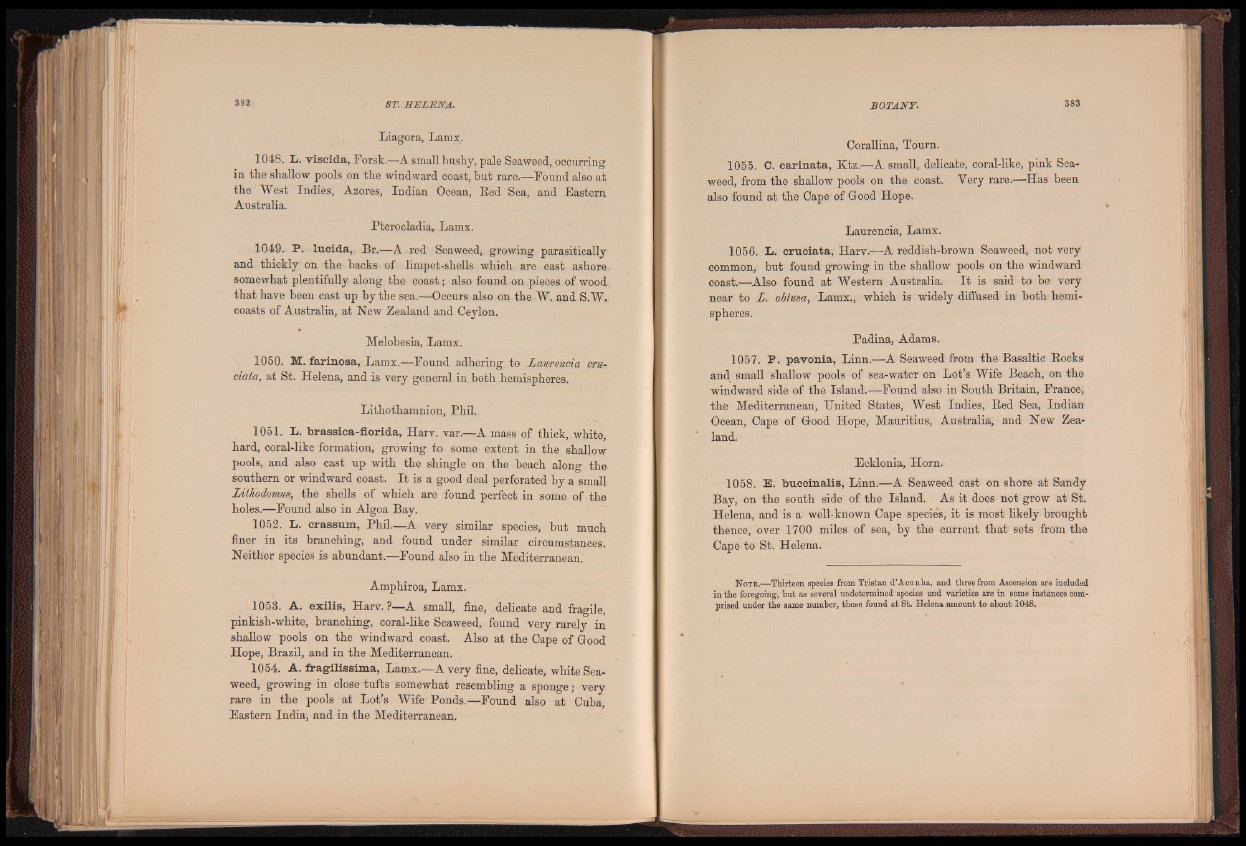
Liagora, Lamx;.
1048. L. viscida, Forsk.—A small bushy, pale Seaweed, occurring
in the shallow pools on the windward coast, but rare.—Pound also at
the West Indies, Azores, Indian Ocean, Bed Sea, and Eastern
Australia.
Pterocladia, Lamx.
1049. P. lucida, Br.—A red Seaweed, growing parasitically
and thickly on the hacks of limpet-shells which are cast ashore
somewhat plentifully along the coast; also found on pieces of wood
that have been cast up by the sea.—Occurs also on the W. and S.W,
coasts of Australia, at New Zealand and Ceylon.
Melobesia, Lamx.
1050. M. farinosa, Lamx.—Found adhering to Laurencia cru-
ciata, at St. Helena, and is very general in both hemispheres.
Lithothamnion, Phil.
1051. L. brassica-florida, Harv. var.—A mass of thick, white,
hard, coral-like formation, growing to some extent in the shallow
pools, and also cast up with the shingle on the beach along the
southern or windward coast. I t is a good deal perforated by a small
Liihodomus, the shells of which are found perfect in some of the
holes.—Pound also in Algoa Bay.
1052. L. crassum, Phil.—A very similar species, but much
finer in its branching, and found under similar circumstances.
Neither species is abundant.—Pound also in the Mediterranean.
Amphiroa, Lamx.
1053. A. exilis, Harv. ?—A small, fine, delicate and fragile,
pinkish-white, branching, coral-like Seaweed, found very rarely in
shallow pools on the windward coast. Also at the Cape of Good
Hope, Brazil, and in the Mediterranean.
1054. A. fragilissima, Lamx.—Avery fine, delicate, white Seaweed,
growing in close tufts somewhat resembling a sponge; very
rare in the pools at Lot’s Wife Ponds.—Pound also at Cuba,
Eastern India, and in the Mediterranean.
Corallina, Tourn.
1055. C. carinata, Ktz.—A small, delicate, coral-like, pink Seaweed,
from the shallow pools on the coast. Yery rare.—Has been
also found at the Cape of Good Hope.
Laurencia, Lamx.
1056. L. cruciata, Harv.—A. reddish-brown Seaweed, not very
common, but found growing in the shallow pools on the windward
coast.—Also found at Western Australia. I t is said to be very
near to L. obtusa, Lamx., wbich is widely diffused in both hemispheres.
Padina, Adams.
1057. P . pavonia, Linn.—A Seaweed from the Basaltic Bocks
and small shallow pools of sea-water on Lot’s Wife Beach, on the
windward side of the Island.—Found also in South Britain, Prance,
the Mediterranean, United States, West Indies, Bed Sea, Indian
Ocean, Cape of Good Hope, Mauritius, Australia, and New Zealand.
Ecklonia, Horn.
1058. E. buccinalis, Linn.—A Seaweed cast on shore at Sandy
Bay, on the south side of the Island. As it does not grow at St.
Helena, and is a well-known Cape species, it is most likely brought
thence, over 1700 miles of sea, by the current that sets from the
Cape to St. Helena.
N o t e .—Thirteen species from Tristan d’Acunha, and three from Ascension are included
in the foregoing, hut as several undetermined species and varieties are in some instances comprised
under the same number, those found at St. Helena amount to about 1048.